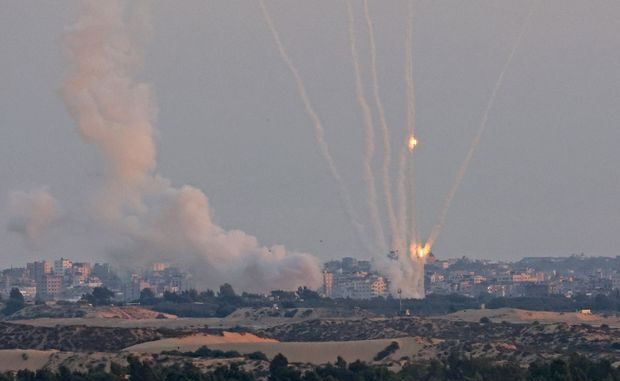The Jewish state should destroy Palestinian arsenals before terrorists use them.
By Aug. 8, 2022 2:08 pm ET
Rockets from Gaza as seen from Ashkelon, Israel, Aug. 7.PHOTO: JACK GUEZ/
Another round of fighting in Gaza has ended with a brokered cease-fire after a limited yet deadly exchange of fire between a terror organization and the Israel Defense Forces. The fighting lasted three days, more than 1,000 rockets were fired at Israel—including toward Tel Aviv and Jerusalem—and millions of Israelis found cover and relative safety thanks to the phenomenal Iron Dome, which intercepted more than 96% of the lethal rockets aimed at Israeli civilians.
At least 20 operatives of Palestinian Islamic Jihad were killed in action by the IDF, and scores more were wounded. Most important, almost the entire chain of command of the Islamic Jihad was eliminated in separate pinpoint strikes, leaving that organization with significant staffing shortages for the foreseeable future. Sadly, several Gazan civilians were also killed, either inadvertently by the IDF or by malfunctioning Palestinian rockets fired by terrorists.
None of the above should be surprising or sound new to anyone who has been following Middle Eastern news for the past 15 years. Other rounds, like Operation Guardian of the Walls in May 2021, lasted longer, caused more casualties and destruction in Israel and in Gaza, and ended in similar fashion.
What has changed, however, are the capabilities of the terror organizations in Gaza. A few years ago, the biggest rockets in Gaza barely reached 15 miles, yet today they can deliver dozens of pounds of explosives north of Tel Aviv (60 miles) and effectively have between three million and four million Israelis within range. Hamas and Islamic Jihad have also accumulated advanced antitank missiles—not inferior to the ones Ukraine has used to halt Russian advances—as well as explosive unmanned aerial vehicles and other lethal weapons. Much if not all of this weaponry has been smuggled into the Gaza Strip through Egypt, and the vast majority of the advanced weapons were either paid for or manufactured by Iran.
To understand the current quagmire, let’s revisit a few historical milestones. Israel tried to make peace with the Palestinians and started the infamous Oslo process by handing over control of the major cities in the strip to the Palestinian Authority in the early 1990s, only to see a sharp rise in terror activity against Israel. In 2005 Israel withdrew unilaterally from the entire Gaza Strip, evicting almost 10,000 Israelis from their homes, hoping for Gaza to prosper under self-governance. It took Hamas little over a year to take control over the Gaza Strip from the feeble and corrupt Palestinian Authority and turn it into a weapons depot and launchpad against Israel. Since 2007, terrorists have repeatedly ravaged the Israeli communities around the Gaza Strip, with each round of attacks engulfing more Israelis under rocket fire.
Israel’s strategy has failed, and we are in desperate need of fresh thinking. In 2011, when I was deputy division commander in charge of defending Israeli communities along the border with the Gaza Strip, that strategy might have made sense, but today it is evident to all that it has run its course.
Based on the sober premise that no peace treaty with Gaza is on the horizon, I urge the Israeli government and defense establishment to recalibrate its course and define new goals. We can’t sit idly by while jihadist thugs stockpile arsenals larger than those of many European countries at our doorstep, constantly adding range and payloads. We must not allow previous strategic blunders to seal the fate of coming generations of Israelis. We need to take action and address the problem at hand, while being ready to face the immediate consequences to gain long-term benefits.
Hamas and the other terror organizations mustn’t be allowed to stockpile rockets, and Israel should eliminate them before the enemy uses them. When intelligence confirms their location, the military should strike immediately. The subterranean highways connecting Gaza and Egyptian Sinai must be blocked, or millions of Israelis will remain under rocket threat.
The IDF and the rest of the defense establishment should apply the same principles they use in mitigating Iranian presence in Syria against terror organizations in Gaza with more firepower and less restraint, because Israeli civilians are at risk. In plain English, Israel should set out to eliminate the military capabilities possessed by terror organizations in Gaza, and not allow them to rebuild and grow between rounds of fighting.
I am confident that the IDF, if ordered to do so by Israel’s elected officials, will find the best possible way to accomplish this complex task. Today, however, the state of Israel is failing its citizens in providing the most fundamental of services: security.
Mr. Avivi is CEO of the Israel Defense and Security Forum. He served as a brigadier general in the IDF and deputy division commander of the Gaza Division.




I read somewhere recently that they have trapdoors that open to launch missiles from underground and then close next to crowded residential areas. Without boots on the ground, does technology currently exist that can accurately target these camouflaged sites?